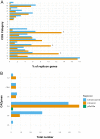Genomic and physiological characterization of Novosphingobium terrae sp. nov., an alphaproteobacterium isolated from Cerrado soil containing a mega-sized chromid
- PMID: 36701110
- PMCID: PMC9944591
- DOI: 10.1007/s42770-022-00900-4
Genomic and physiological characterization of Novosphingobium terrae sp. nov., an alphaproteobacterium isolated from Cerrado soil containing a mega-sized chromid
Abstract
A novel bacterial strain, designated GeG2T, was isolated from soils of the native Cerrado, a highly biodiverse savanna-like Brazilian biome. 16S rRNA gene analysis of GeG2T revealed high sequence identity (100%) to the alphaproteobacterium Novosphingobium rosa; however, comparisons with N. rosa DSM 7285T showed several distinctive features, prompting a full characterization of the new strain in terms of physiology, morphology, and, ultimately, its genome. GeG2T cells were Gram-stain-negative bacilli, facultatively anaerobic, motile, positive for catalase and oxidase activities, and starch hydrolysis. Strain GeG2T presented planktonic-sessile dimorphism and cell aggregates surrounded by extracellular matrix and nanometric spherical structures were observed, suggesting the production of exopolysaccharides (EPS) and outer membrane vesicles (OMVs). Despite high 16S rDNA identity, strain GeG2T showed 90.38% average nucleotide identity and 42.60% digital DNA-DNA hybridization identity with N. rosa, below species threshold. Whole-genome assembly revealed four circular replicons: a 4.1 Mb chromosome, a 2.7 Mb extrachromosomal megareplicon, and two plasmids (212.7 and 68.6 kb). The megareplicon contains a few core genes and plasmid-type replication/maintenance systems, consistent with its classification as a chromid. Genome annotation shows a vast repertoire of carbohydrate-active enzymes and genes involved in the degradation of aromatic compounds, highlighting the biotechnological potential of the new isolate. Chemotaxonomic features, including polar lipid and fatty acid profiles, as well as physiological, molecular, and whole-genome comparisons showed significant differences between strain GeG2T and N. rosa, indicating that it represents a novel species, for which the name Novosphingobium terrae is proposed. The type strain is GeG2T (= CBMAI 2313T = CBAS 753 T).
Keywords: Cerrado; Chromid; Cultivation; Novosphingobium; Soils; Sphingomonadales.
© 2023. The Author(s) under exclusive licence to Sociedade Brasileira de Microbiologia.
Conflict of interest statement
The authors declare no competing interests.
Figures








References
-
- Takeuchi M, Sakane T, Yanagi M, Yamasato K, Hamana K, Yokota A. Taxonomic study of bacteria isolated from plants: proposal of Sphingomonas rosa sp. nov., Sphingomonas pruni sp. nov., Sphingomonas asaccharolytica sp. nov., and Sphingomonas mali sp. nov. Int J Syst Bacteriol. 1995;45(2):334–341. doi: 10.1099/00207713-45-2-334. - DOI - PubMed
MeSH terms
Substances
LinkOut - more resources
Full Text Sources
Molecular Biology Databases
Miscellaneous

